Implementing Circular Economy Elements in the Textile Industry: A Bibliometric Analysis
Abstract
:1. Introduction
Research Objectives
2. Materials and Methods
3. Results
3.1. Period 1975–2010
3.1.1. Top Contributors in Global Textile Industry Research (1975–2010)
3.1.2. Leading Contributors in Textile Industry Research (1975–2010)
3.1.3. Exploring Prolific Contributors (1975–2010)
3.1.4. Highly Cited Articles in Textile Industry Research (1975–2010)
3.1.5. Co-Authorship Patterns in the Textile Industry (1975–2010)
3.1.6. Citation Map of Sources (1975–2010)
3.1.7. A Visual Exploration of the Most Influential Terms in the Textile Industry (1975–2010)
3.1.8. Key Terms and Emerging Patterns in the Textile Industry (1975–2010)
3.2. Period 2011–2023
3.2.1. Top Contributors in Global Textile Industry Research (2011–2023)
3.2.2. Leading Contributors in Textile Industry Research (2011–2023)
3.2.3. Exploring Prolific Contributors (2011–2023)
3.2.4. Highly Cited Articles in Textile Industry Research (2011–2023)
3.2.5. Co-Authorship Patterns in the Textile Industry (2011–2023)
3.2.6. Citation Map of Sources (2011–2023)
3.2.7. A Visual Exploration of The Most Influential Terms in the Textile Industry (2011–2023)
3.2.8. Key Terms and Emerging Patterns in the Textile Industry (2011–2023)
4. Discussion
5. Conclusions
Research Limitations and Future Research Directions
Author Contributions
Funding
Conflicts of Interest
References
- Juanga-Labayen, J.P.; Labayen, I.V.; Yuan, Q. A Review on Textile Recycling Practices and Challenges. Textiles 2022, 2, 174–188. [Google Scholar] [CrossRef]
- Rana, S.; Pichandi, S.; Moorthy, S.; Bhattacharyya, A.; Parveen, S.; Fangueiro, R. Carbon Footprint of Textile and Clothing Products. In Handbook of Sustainable Apparel Production; CRC Press: Boca Raton, FL, USA, 2015; pp. 141–166. ISBN 978-1-4822-9937-3. [Google Scholar]
- Perera, F. Pollution from Fossil-Fuel Combustion Is the Leading Environmental Threat to Global Pediatric Health and Equity: Solutions Exist. Int. J. Environ. Res. Public Health 2017, 15, 16. [Google Scholar] [CrossRef] [PubMed]
- Solomon, C.G.; Salas, R.N.; Malina, D.; Sacks, C.A.; Hardin, C.C.; Prewitt, E.; Lee, T.H.; Rubin, E.J. Fossil-Fuel Pollution and Climate Change—A New NEJM Group Series. N. Engl. J. Med. 2022, 386, 2328–2329. [Google Scholar] [CrossRef]
- Matei, O.-R.; Dumitrescu Silaghi, L.; Dunca, E.-C.; Bungau, S.G.; Tit, D.M.; Mosteanu, D.-E.; Hodis, R. Study of Chemical Pollutants and Ecological Reconstruction Methods in the Tismana I Quarry, Rovinari Basin, Romania. Sustainability 2022, 14, 7160. [Google Scholar] [CrossRef]
- Behl, T.; Kaur, I.; Sehgal, A.; Singh, S.; Sharma, N.; Bhatia, S.; Al-Harrasi, A.; Bungau, S. The Dichotomy of Nanotechnology as the Cutting Edge of Agriculture: Nano-Farming as an Asset versus Nanotoxicity. Chemosphere 2022, 288, 132533. [Google Scholar] [CrossRef] [PubMed]
- Omer, M.M.; Rahman, R.A.; Almutairi, S. Construction Waste Recycling: Enhancement Strategies and Organization Size. Phys. Chem. Earth Parts A/B/C 2022, 126, 103114. [Google Scholar] [CrossRef]
- Bungău, C.C.; Prada, I.F.; Prada, M.; Bungău, C. Design and Operation of Constructions: A Healthy Living Environment-Parametric Studies and New Solutions. Sustainability 2019, 11, 6824. [Google Scholar] [CrossRef]
- Prada, M.; Prada, I.F.; Cristea, M.; Popescu, D.E.; Bungău, C.; Aleya, L.; Bungău, C.C. New Solutions to Reduce Greenhouse Gas Emissions through Energy Efficiency of Buildings of Special Importance—Hospitals. Sci. Total Environ. 2020, 718, 137446. [Google Scholar] [CrossRef]
- Bungau, S.G.; Suciu, R.N.; Bumbu, A.G.; Cioca, G.; Tit, D.M. Study on Hospital Waste Management in Medical Rehabilitation Clinical Hospital, Baile Felix. J. Environ. Prot. Ecol. 2015, 16, 980–987. [Google Scholar]
- Tit, D.M.; Bungau, S.G.; Nistor-Cseppento, D.C.; Copolovici, D.M.; Buhas, C.L. Disposal of Unused Medicines Resulting from Home Treatment in Romania. J. Environ. Prot. Ecol. 2016, 17, 1425–1433. [Google Scholar]
- Bailey, K.; Basu, A.; Sharma, S. The Environmental Impacts of Fast Fashion on Water Quality: A Systematic Review. Water 2022, 14, 1073. [Google Scholar] [CrossRef]
- Schumacher, K.; Forster, A. Textiles in a Circular Economy: An Assessment of the Current Landscape, Challenges, and Opportunities in the United States. Front. Sustain. 2022, 3, 1038323. [Google Scholar] [CrossRef]
- Leal Filho, W.; Perry, P.; Heim, H.; Dinis, M.A.P.; Moda, H.; Ebhuoma, E.; Paço, A. An Overview of the Contribution of the Textiles Sector to Climate Change. Front. Environ. Sci. 2022, 10, 973102. [Google Scholar] [CrossRef]
- Rathi, R.; Sabale, D.B.; Antony, J.; Kaswan, M.S.; Jayaraman, R. An Analysis of Circular Economy Deployment in Developing Nations’ Manufacturing Sector: A Systematic State-of-the-Art Review. Sustainability 2022, 14, 11354. [Google Scholar] [CrossRef]
- European Parliament. The Impact of Textile Production and Waste on the Environment (Infographics). Available online: https://www.europarl.europa.eu/news/en/headlines/society/20201208STO93327/the-impact-of-textile-production-and-waste-on-the-environment-infographics (accessed on 25 September 2023).
- Textile World. Fiber World: Sustainability In Fiber Manufacturing. Available online: https://www.textileworld.com/textile-world/features/2021/05/fiber-world-sustainability-in-fiber-manufacturing/ (accessed on 11 September 2023).
- Harsanto, B.; Primiana, I.; Sarasi, V.; Satyakti, Y. Sustainability Innovation in the Textile Industry: A Systematic Review. Sustainability 2023, 15, 1549. [Google Scholar] [CrossRef]
- de Oliveira Neto, G.C.; Ferreira Correia, J.M.; Silva, P.C.; de Oliveira Sanches, A.G.; Lucato, W.C. Cleaner Production in the Textile Industry and Its Relationship to Sustainable Development Goals. J. Clean. Prod. 2019, 228, 1514–1525. [Google Scholar] [CrossRef]
- de Oliveira Neto, G.C.; Cesar da Silva, P.; Tucci, H.N.P.; Amorim, M. Reuse of Water and Materials as a Cleaner Production Practice in the Textile Industry Contributing to Blue Economy. J. Clean. Prod. 2021, 305, 127075. [Google Scholar] [CrossRef]
- Enes, E.; Kipöz, Ş. The Role of Fabric Usage for Minimization of Cut-and-Sew Waste within the Apparel Production Line: Case of a Summer Dress. J. Clean. Prod. 2020, 248, 119221. [Google Scholar] [CrossRef]
- Muthu, S.S. (Ed.) Consumer Awareness and Textile Sustainability, 1st ed.; Springer: Cham, Switzerland, 2023; ISBN 978-3-031-43878-3. [Google Scholar]
- Yadav, V.; Kaswan, M.S.; Gahlot, P.; Duhan, R.K.; Garza-Reyes, J.A.; Rathi, R.; Chaudhary, R.; Yadav, G. Green Lean Six Sigma for Sustainability Improvement: A Systematic Review and Future Research Agenda. Int. J. Lean Six Sigma 2023, 14, 759–790. [Google Scholar] [CrossRef]
- Islam, S. Waste Management Strategies in Fashion and Textiles Industry: Challenges Are in Governance, Materials Culture and Design-Centric. In Waste Management in the Fashion and Textile Industries; The Textile Institute Book Series; Nayak, R., Patnaik, A., Eds.; Woodhead Publishing: Cambridge, UK, 2021; pp. 275–293. ISBN 978-0-12-818758-6. [Google Scholar]
- Khairul Akter, M.M.; Haq, U.N.; Islam, M.M.; Uddin, M.A. Textile-Apparel Manufacturing and Material Waste Management in the Circular Economy: A Conceptual Model to Achieve Sustainable Development Goal (SDG) 12 for Bangladesh. Clean. Environ. Syst. 2022, 4, 100070. [Google Scholar] [CrossRef]
- Gardetti, M.A. Introduction and the Concept of Circular Economy. In Circular Economy in Textiles and Apparel; The Textile Institute Book Series; Muthu, S.S., Ed.; Woodhead Publishing: Cambridge, UK, 2019; pp. 1–11. ISBN 978-0-08-102630-4. [Google Scholar]
- Chen, X.; Memon, H.A.; Wang, Y.; Marriam, I.; Tebyetekerwa, M. Circular Economy and Sustainability of the Clothing and Textile Industry. Mater. Circ. Econ. 2021, 3, 12. [Google Scholar] [CrossRef]
- Chae, Y.; Hinestroza, J. Building Circular Economy for Smart Textiles, Smart Clothing, and Future Wearables. Mater. Circ. Econ. 2020, 2, 2. [Google Scholar] [CrossRef]
- Jia, F.; Yin, S.; Chen, L.; Chen, X. The Circular Economy in the Textile and Apparel Industry: A Systematic Literature Review. J. Clean. Prod. 2020, 259, 120728. [Google Scholar] [CrossRef]
- Craiut, L.; Bungau, C.; Bungau, T.; Grava, C.; Otrisal, P.; Radu, A.F. Technology Transfer, Sustainability, and Development, Worldwide and in Romania. Sustainability 2022, 14, 15728. [Google Scholar] [CrossRef]
- Craiut, L.; Bungau, C.; Negru, P.A.; Bungau, T.; Radu, A.-F. Technology Transfer in the Context of Sustainable Development-A Bibliometric Analysis of Publications in the Field. Sustainability 2022, 14, 11973. [Google Scholar] [CrossRef]
- Chauhan, C.; Parida, V.; Dhir, A. Linking Circular Economy and Digitalisation Technologies: A Systematic Literature Review of Past Achievements and Future Promises. Technol. Forecast. Soc. Chang. 2022, 177, 121508. [Google Scholar] [CrossRef]
- Han, Y.; Shevchenko, T.; Yannou, B.; Ranjbari, M.; Shams Esfandabadi, Z.; Saidani, M.; Bouillass, G.; Bliumska-Danko, K.; Li, G. Exploring How Digital Technologies Enable a Circular Economy of Products. Sustainability 2023, 15, 2067. [Google Scholar] [CrossRef]
- Rajput, S.; Singh, S.P. Connecting Circular Economy and Industry 4.0. Int. J. Inf. Manag. 2019, 49, 98–113. [Google Scholar] [CrossRef]
- Khan, S.; Zia-ul-haq, H.; Umar, M.; Yu, Z. Digital Technology and Circular Economy Practices: An Strategy to Improve Organizational Performance. Bus. Strateg. Dev. 2021, 4, 482–490. [Google Scholar] [CrossRef]
- Khan, S.A.R.; Piprani, A.Z.; Yu, Z. Digital Technology and Circular Economy Practices: Future of Supply Chains. Oper. Manag. Res. 2022, 15, 676–688. [Google Scholar] [CrossRef]
- Tanveer, M.; Khan, S.A.R.; Umar, M.; Yu, Z.; Sajid, M.J.; Haq, I.U. Waste Management and Green Technology: Future Trends in Circular Economy Leading towards Environmental Sustainability. Environ. Sci. Pollut. Res. 2022, 29, 80161–80178. [Google Scholar] [CrossRef]
- Çetin, S.; De Wolf, C.; Bocken, N. Circular Digital Built Environment: An Emerging Framework. Sustainability 2021, 13, 6348. [Google Scholar] [CrossRef]
- Ghobakhloo, M.; Iranmanesh, M.; Tseng, M.L.; Grybauskas, A.; Stefanini, A.; Amran, A. Behind the Definition of Industry 5.0: A Systematic Review of Technologies, Principles, Components, and Values. J. Ind. Prod. Eng. 2023, 40, 432–447. [Google Scholar] [CrossRef]
- Kumar, U.; Kaswan, M.S.; Kumar, R.; Chaudhary, R.; Garza-Reyes, J.A.; Rathi, R.; Joshi, R. A Systematic Review of Industry 5.0 from Main Aspects to the Execution Status. TQM J. 2023. [Google Scholar] [CrossRef]
- Kristoffersen, E.; Blomsma, F.; Mikalef, P.; Li, J. The Smart Circular Economy: A Digital-Enabled Circular Strategies Framework for Manufacturing Companies. J. Bus. Res. 2020, 120, 241–261. [Google Scholar] [CrossRef]
- Magsi, N.; Khan, S.; Ashraf, M.; Sheikh, A. Interconnection between the Role of Blockchain Technologies, Supply Chain Integration, and Circular Economy: A Case of Small and Medium-Sized Enterprises in Pakistan. Sci. Prog. 2023, 106, 1–22. [Google Scholar]
- Wiegand, T.; Wynn, M. Sustainability, the Circular Economy and Digitalisation in the German Textile and Clothing Industry. Sustainability 2023, 15, 9111. [Google Scholar] [CrossRef]
- Mayes-Ramírez, M.M.; Gálvez-Sánchez, F.J.; Ramos-Ridao, Á.F.; Molina-Moreno, V. Urban Waste: Visualizing the Academic Literature through Bibliometric Analysis and Systematic Review. Sustainability 2023, 15, 1846. [Google Scholar] [CrossRef]
- García-Rivas, M.I.; Gálvez-Sánchez, F.J.; Noguera-Vivo, J.M.; Meseguer-Sánchez, V. Corporate Social Responsibility Reports: A Review of the Evolution, Approaches and Prospects. Heliyon 2023, 9, e18348. [Google Scholar] [CrossRef]
- van Eck, N.J.; Waltman, L. Citation-Based Clustering of Publications Using CitNetExplorer and VOSviewer. Scientometrics 2017, 111, 1053–1070. [Google Scholar] [CrossRef]
- Robinson, T.; McMullan, G.; Marchant, R.; Nigam, P. Remediation of Dyes in Textile Effluent: A Critical Review on Current Treatment Technologies with a Proposed Alternative. Bioresour. Technol. 2001, 77, 247–255. [Google Scholar] [CrossRef] [PubMed]
- Crini, G. Non-Conventional Low-Cost Adsorbents for Dye Removal: A Review. Bioresour. Technol. 2006, 97, 1061–1085. [Google Scholar] [CrossRef]
- Rafatullah, M.; Sulaiman, O.; Hashim, R.; Ahmad, A. Adsorption of Methylene Blue on Low-Cost Adsorbents: A Review. J. Hazard. Mater. 2010, 177, 70–80. [Google Scholar] [CrossRef] [PubMed]
- Houas, A.; Lachheb, H.; Ksibi, M.; Elaloui, E.; Guillard, C.; Herrmann, J.-M. Photocatalytic Degradation Pathway of Methylene Blue in Water. Appl. Catal. B Environ. 2001, 31, 145–157. [Google Scholar] [CrossRef]
- Martínez-Huitle, C.A.; Brillas, E. Decontamination of Wastewaters Containing Synthetic Organic Dyes by Electrochemical Methods: A General Review. Appl. Catal. B Environ. 2009, 87, 105–145. [Google Scholar] [CrossRef]
- John, M.J.; Thomas, S. Biofibres and Biocomposites. Carbohydr. Polym. 2008, 71, 343–364. [Google Scholar] [CrossRef]
- Banat, I.M.; Nigam, P.; Singh, D.; Marchant, R. Microbial Decolorization of Textile-Dyecontaining Effluents: A Review. Bioresour. Technol. 1996, 58, 217–227. [Google Scholar] [CrossRef]
- Pantelopoulos, A.; Bourbakis, N. A Survey on Wearable Sensor-Based Systems for Health Monitoring and Prognosis. Syst. Man Cybern. Part C Appl. Rev. IEEE Trans. 2010, 40, 1–12. [Google Scholar] [CrossRef]
- Lachheb, H.; Puzenat, E.; Houas, A.; Ksibi, M.; Elaloui, E.; Guillard, C.; Herrmann, J.-M. Photocatalytic Degradation of Various Types of Dyes (Alizarin S, Crocein Orange G, Methyl Red, Congo Red, Methylene Blue) in Water by UV-Irradiated Titania. Appl. Catal. B Environ. 2002, 39, 75–90. [Google Scholar] [CrossRef]
- Kenawy, E.-R.; Worley, S.D.; Broughton, R. The Chemistry and Applications of Antimicrobial Polymers: A State-of-the-Art Review. Biomacromolecules 2007, 8, 1359–1384. [Google Scholar] [CrossRef]
- Hajipour, M.J.; Fromm, K.M.; Akbar Ashkarran, A.; Jimenez de Aberasturi, D.; de Larramendi, I.R.; Rojo, T.; Serpooshan, V.; Parak, W.J.; Mahmoudi, M. Antibacterial Properties of Nanoparticles. Trends Biotechnol. 2012, 30, 499–511. [Google Scholar] [CrossRef]
- Kołodziejczak-Radzimska, A.; Jesionowski, T. Zinc Oxide—From Synthesis to Application: A Review. Materials 2014, 7, 2833–2881. [Google Scholar] [CrossRef] [PubMed]
- Lee, K.M.; Lai, C.W.; Ngai, K.S.; Juan, J.C. Recent Developments of Zinc Oxide Based Photocatalyst in Water Treatment Technology: A Review. Water Res. 2016, 88, 428–448. [Google Scholar] [CrossRef] [PubMed]
- Verma, A.K.; Dash, R.R.; Bhunia, P. A Review on Chemical Coagulation/Flocculation Technologies for Removal of Colour from Textile Wastewaters. J. Environ. Manag. 2012, 93, 154–168. [Google Scholar] [CrossRef] [PubMed]
- Pielichowska, K.; Pielichowski, K. Phase Change Materials for Thermal Energy Storage. Prog. Mater. Sci. 2014, 65, 67–123. [Google Scholar] [CrossRef]
- Martínez-Huitle, C.A.; Rodrigo, M.A.; Sirés, I.; Scialdone, O. Single and Coupled Electrochemical Processes and Reactors for the Abatement of Organic Water Pollutants: A Critical Review. Chem. Rev. 2015, 115, 13362–13407. [Google Scholar] [CrossRef]
- Holkar, C.R.; Jadhav, A.J.; Pinjari, D.V.; Mahamuni, N.M.; Pandit, A.B. A Critical Review on Textile Wastewater Treatments: Possible Approaches. J. Environ. Manag. 2016, 182, 351–366. [Google Scholar] [CrossRef]
- Saratale, R.G.; Saratale, G.D.; Chang, J.S.; Govindwar, S.P. Bacterial Decolorization and Degradation of Azo Dyes: A Review. J. Taiwan Inst. Chem. Eng. 2011, 42, 138–157. [Google Scholar] [CrossRef]
- Kamal, M.S.; Razzak, S.A.; Hossain, M.M. Catalytic Oxidation of Volatile Organic Compounds (VOCs)—A Review. Atmos. Environ. 2016, 140, 117–134. [Google Scholar] [CrossRef]
- Su, B.; Tian, Y.; Jiang, L. Bioinspired Interfaces with Superwettability: From Materials to Chemistry. J. Am. Chem. Soc. 2016, 138, 1727–1748. [Google Scholar] [CrossRef]
- Forno, A.; Bataglini, W.; Steffens, F.; Souza, A. Industry 4.0 in Textile and Apparel Sector: A Systematic Literature Review. Res. J. Text. Appar. 2021, 27, 95–117. [Google Scholar] [CrossRef]
- Halepoto, H.; Gong, T.; Memon, H. A Bibliometric Analysis of Antibacterial Textiles. Sustainability 2022, 14, 11424. [Google Scholar] [CrossRef]
- Mamun, M.A.; Haji, A.; Mahmud, M.H.; Repon, M.R.; Islam, M.T. Bibliometric Evidence on the Trend and Future Direction of the Research on Textile Coloration with Natural Sources. Coatings 2023, 13, 413. [Google Scholar] [CrossRef]
- Halepoto, H.; Gong, T.; Noor, S.; Memon, H. Bibliometric Analysis of Artificial Intelligence in Textiles. Materials 2022, 15, 2910. [Google Scholar] [CrossRef] [PubMed]
- Kasavan, S.; Yusoff, S.; Guan, N.C.; Zaman, N.S.K.; Fakri, M.F.R. Global Trends of Textile Waste Research from 2005 to 2020 Using Bibliometric Analysis. Environ. Sci. Pollut. Res. 2021, 28, 44780–44794. [Google Scholar] [CrossRef] [PubMed]
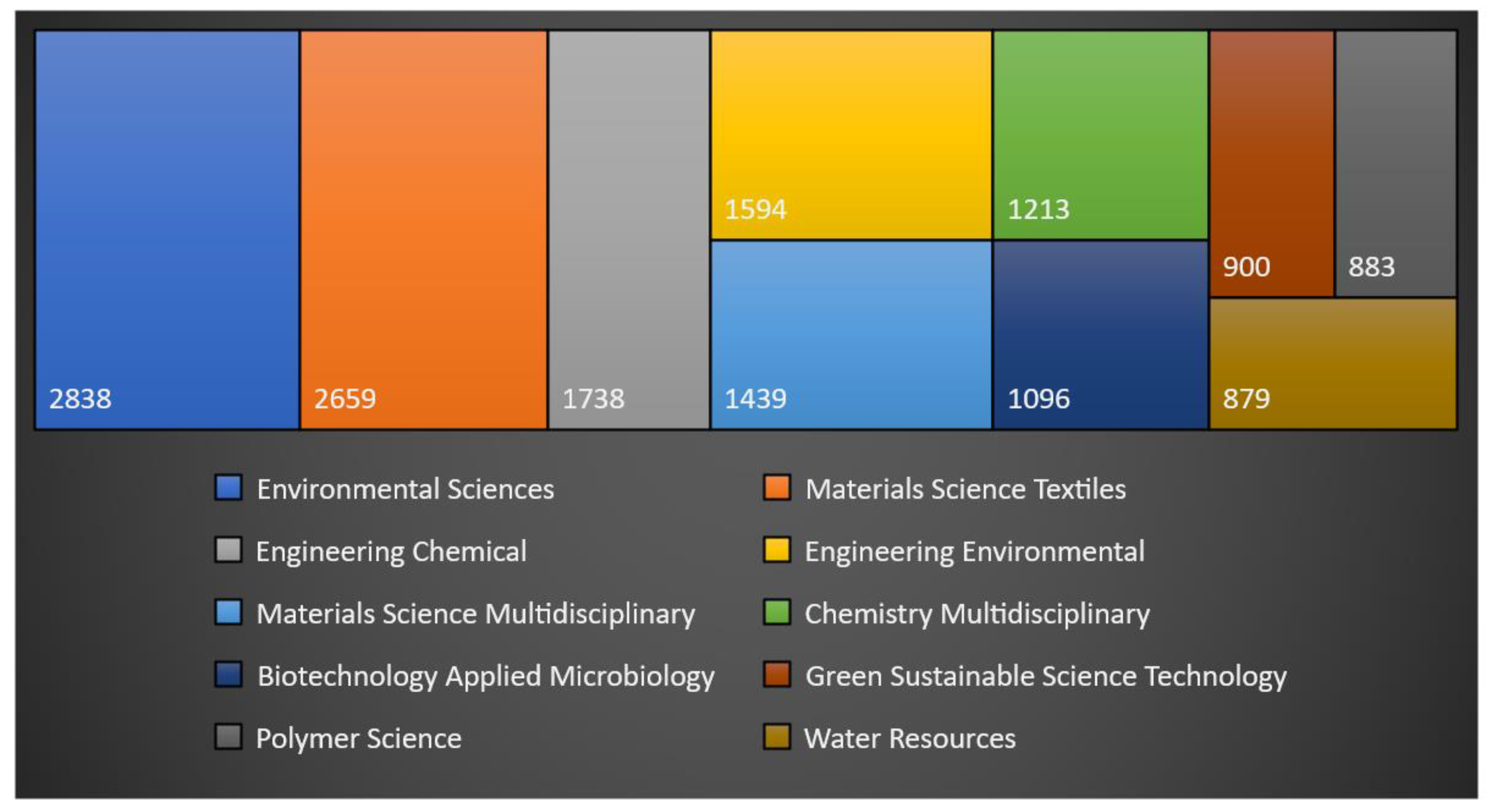
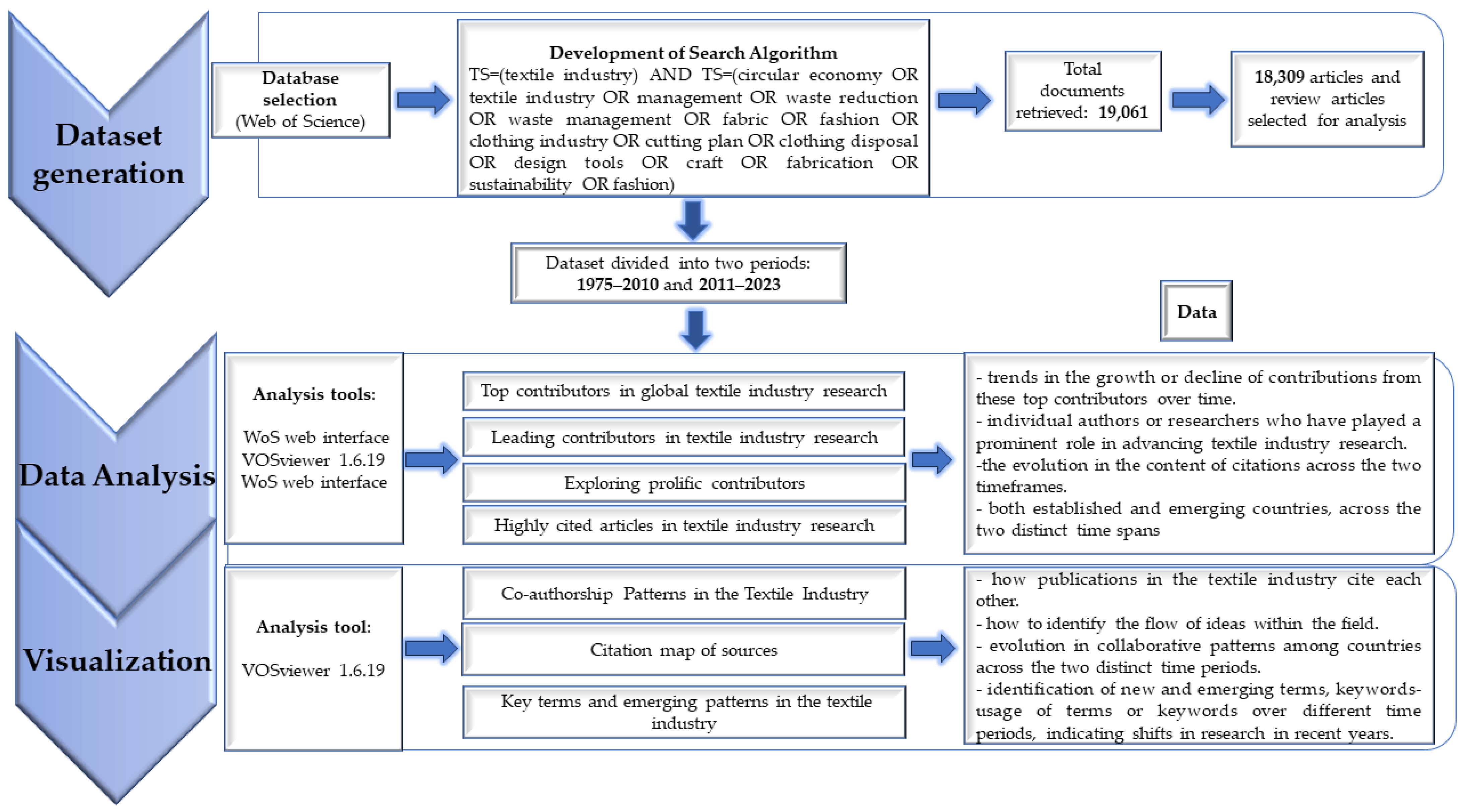
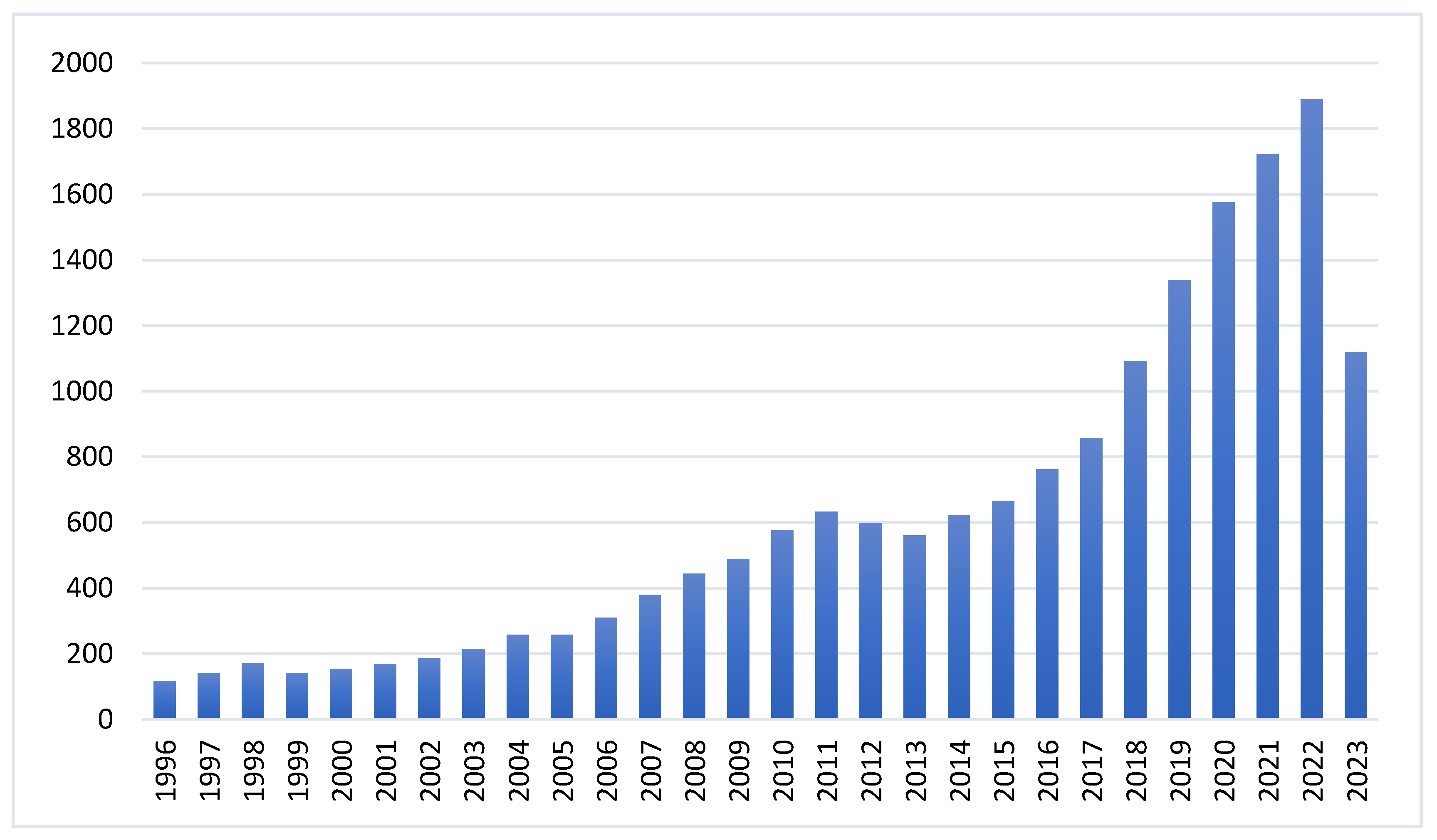
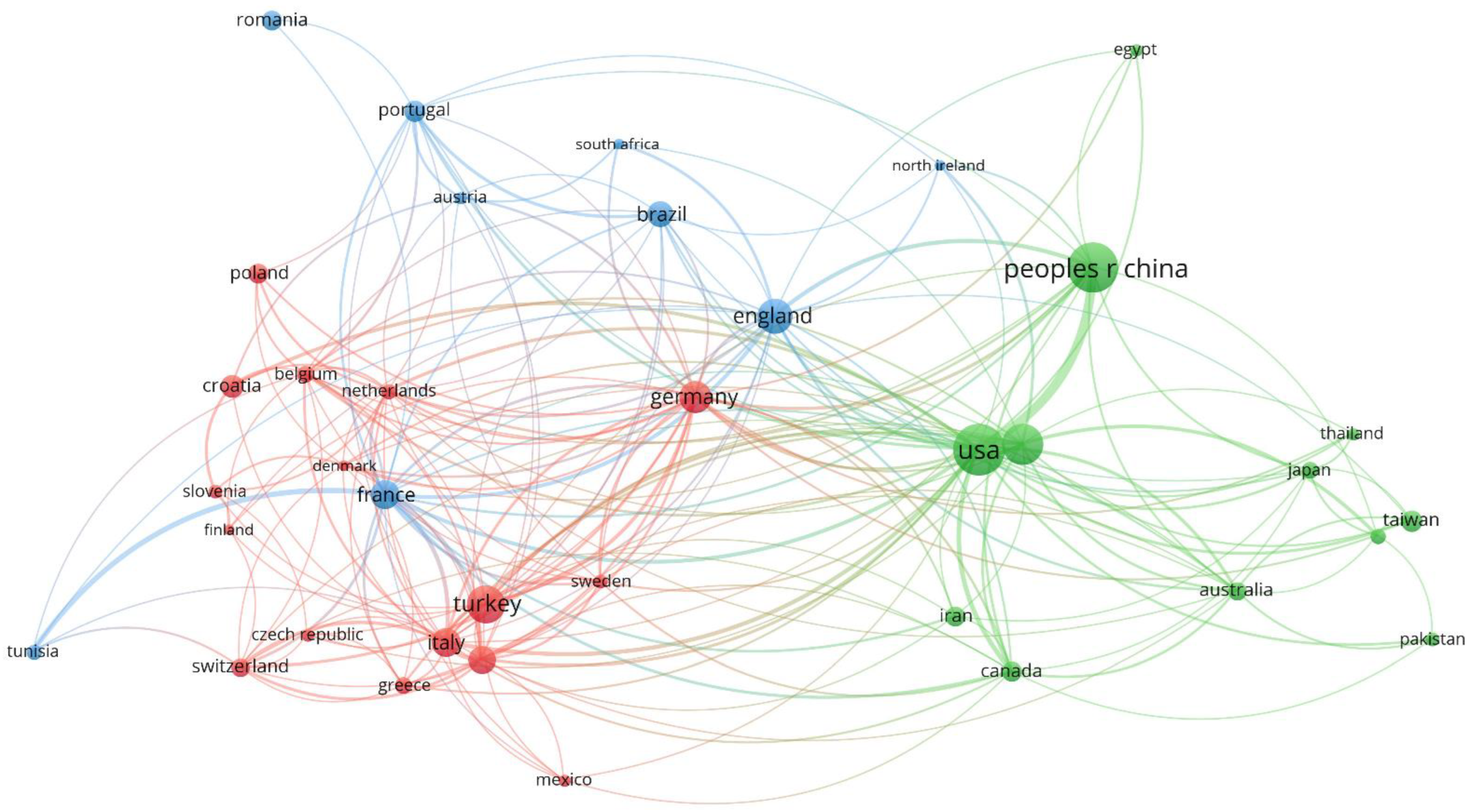
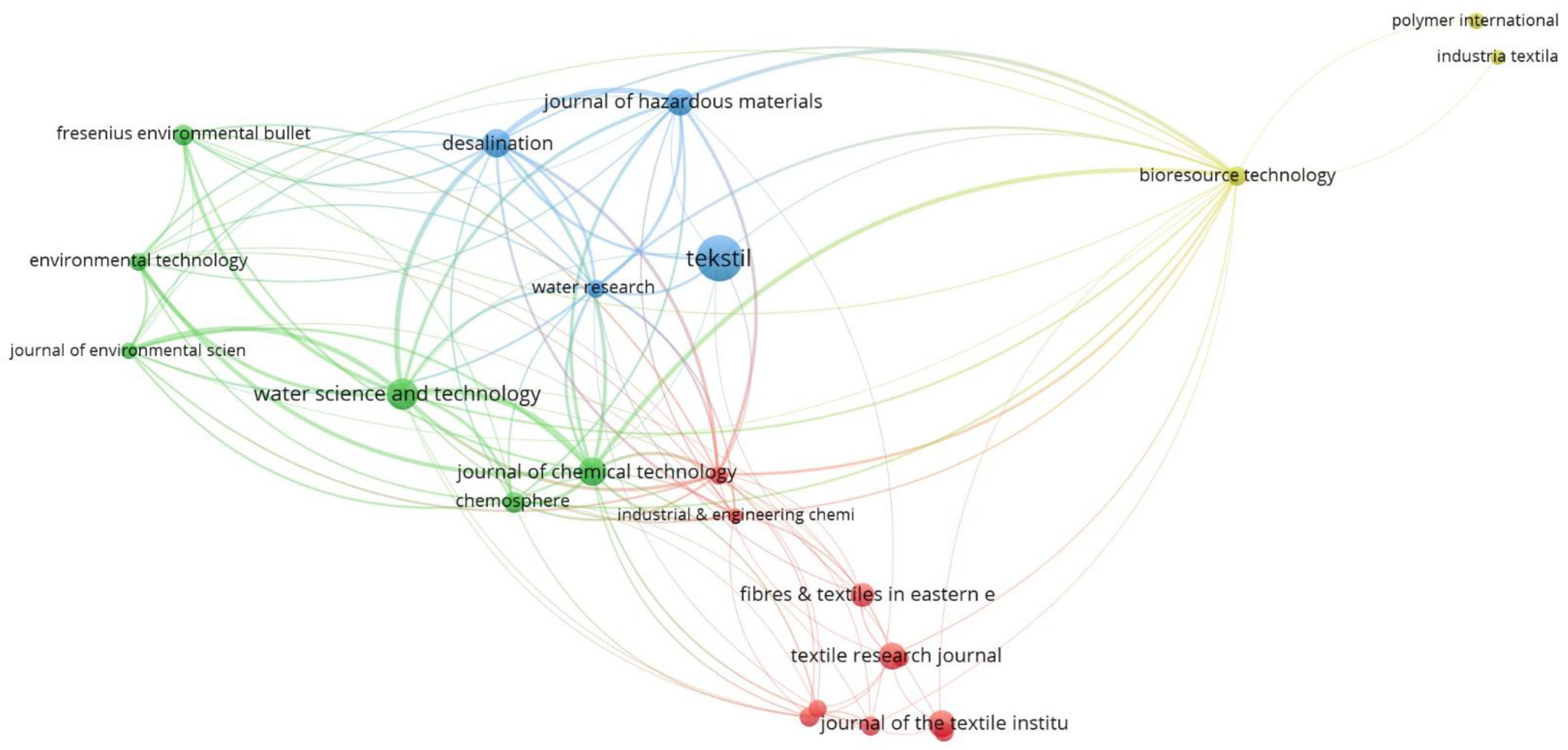
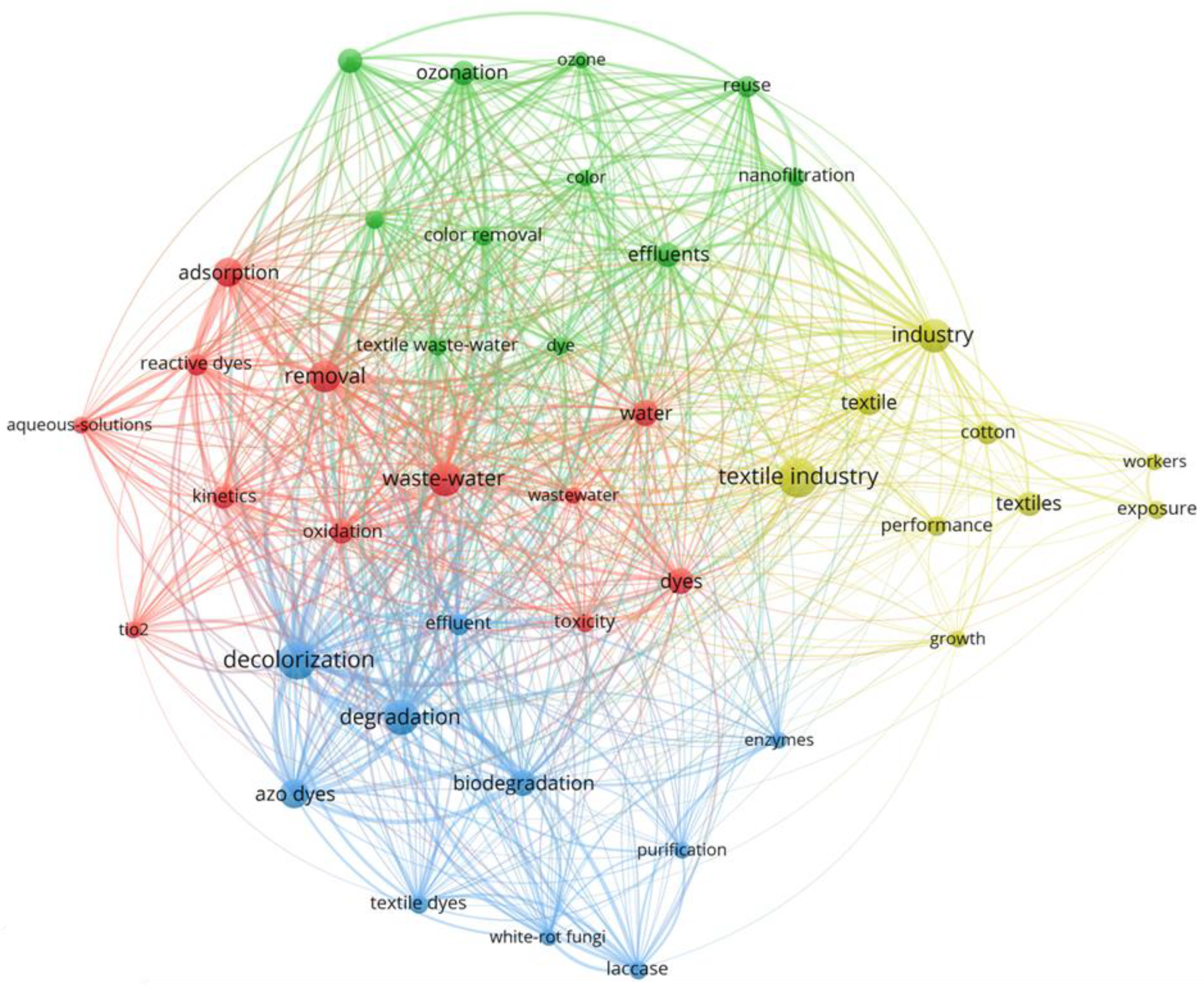
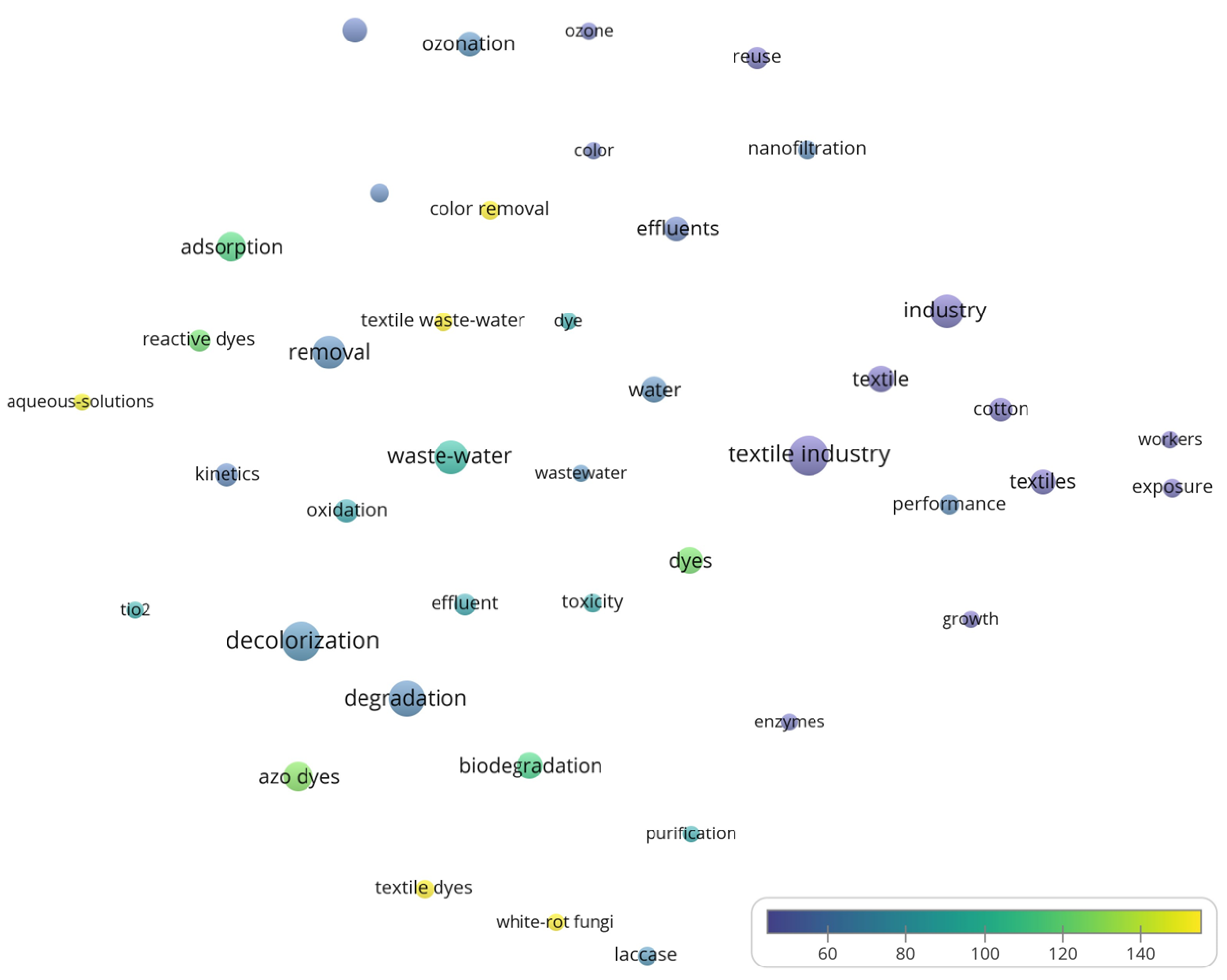
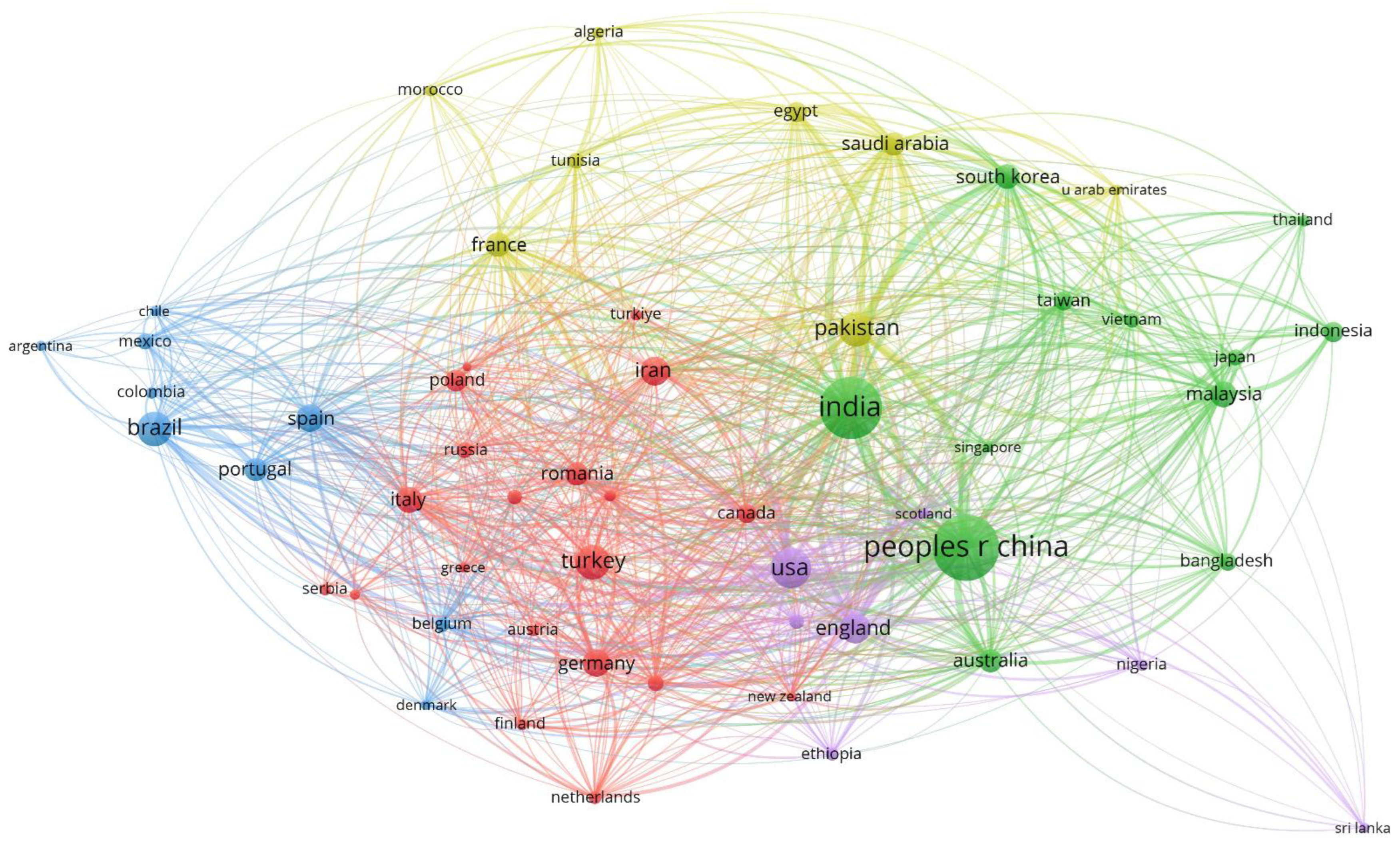
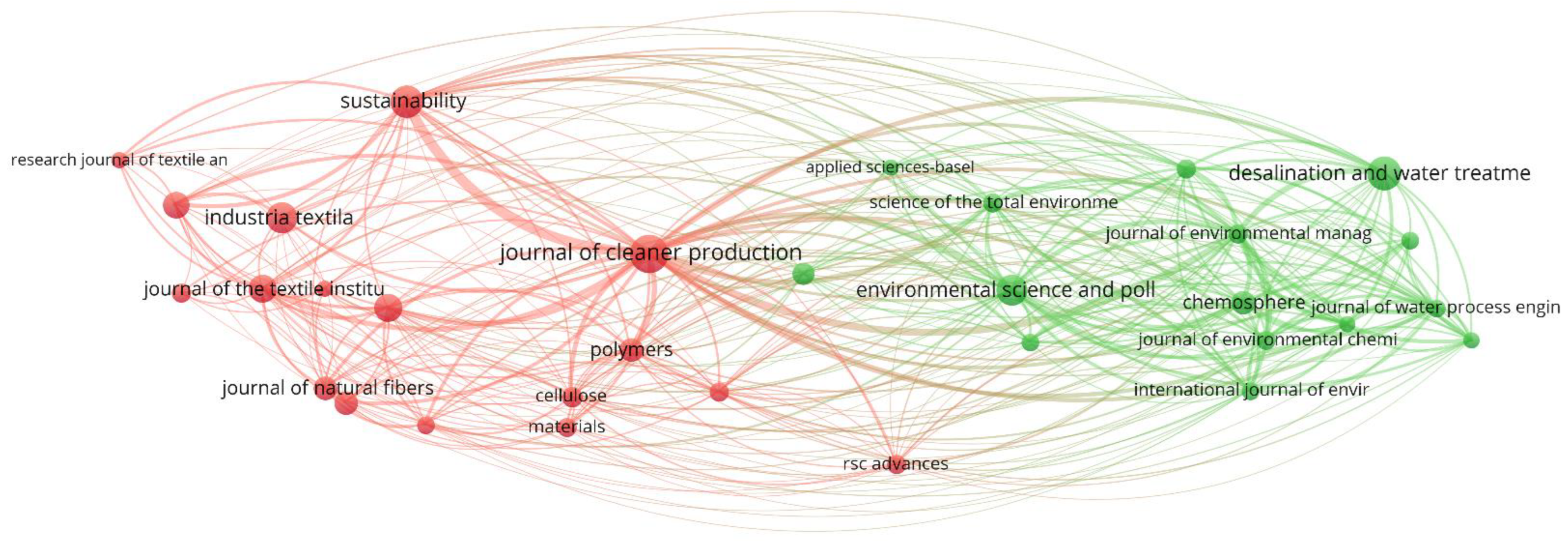
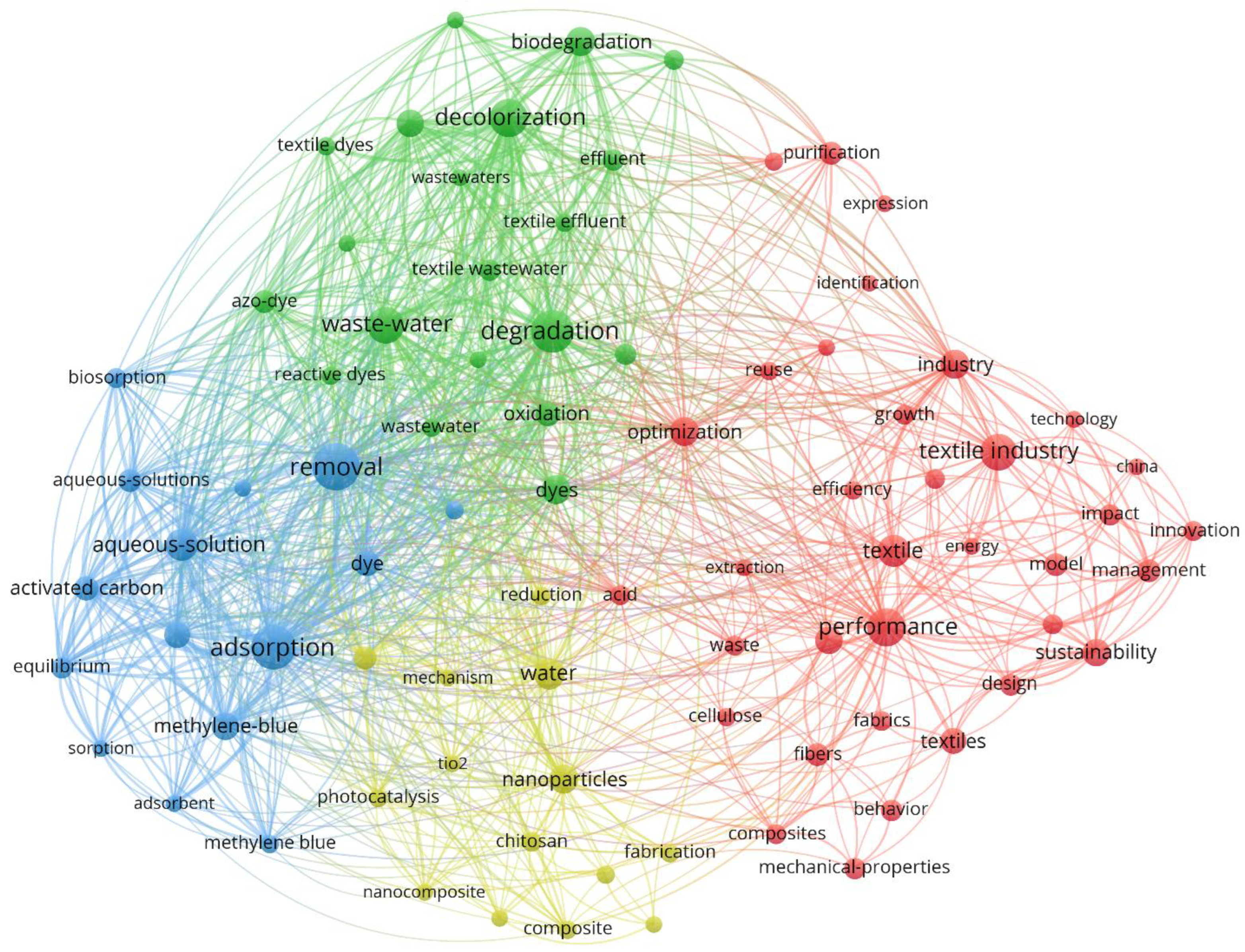
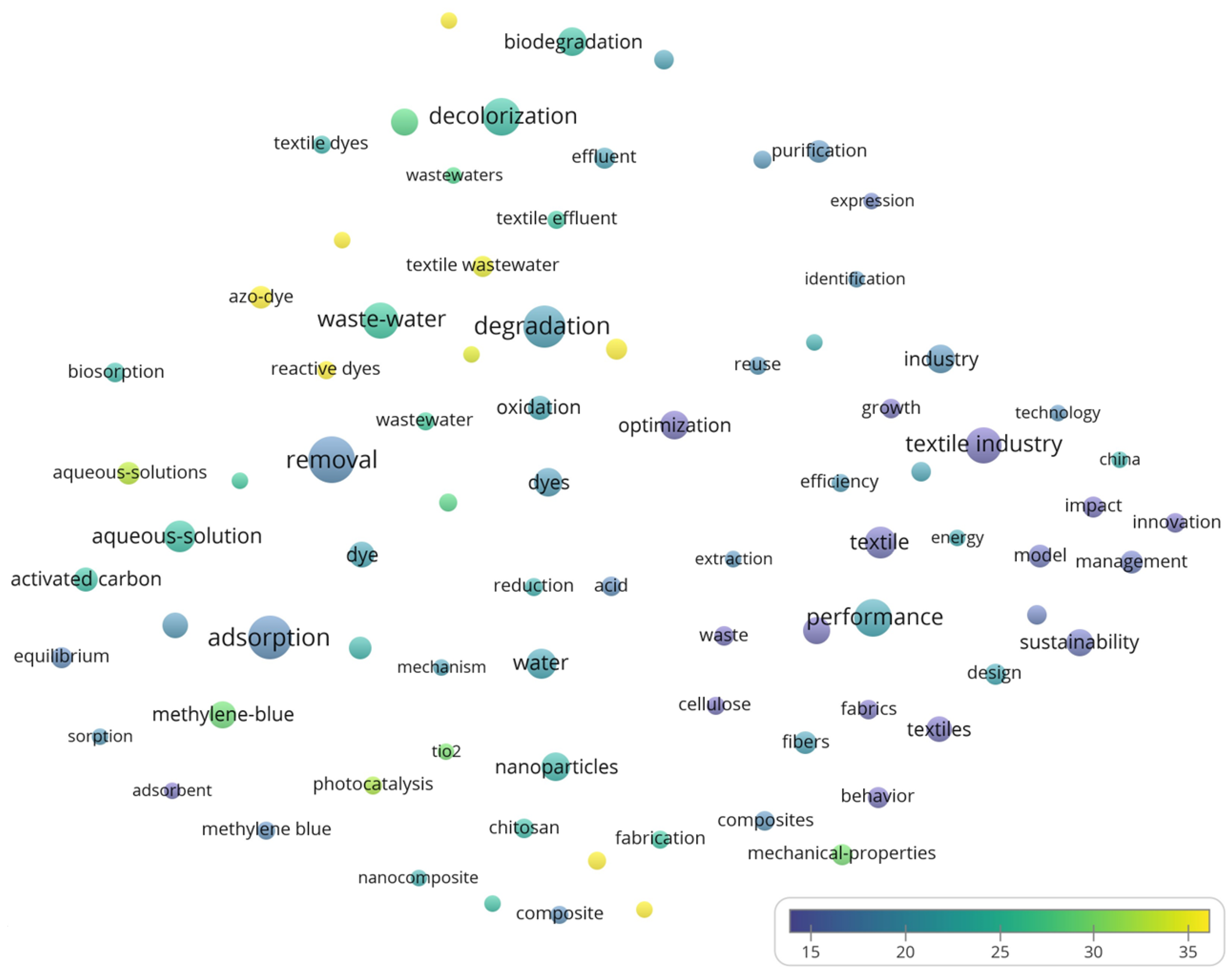
| Country | Documents | Citations | Average Citations/ Document | Total Link Strength |
|---|---|---|---|---|
| United States | 527 | 19,535 | 37.07 | 130 |
| China | 484 | 10,576 | 21.85 | 72 |
| India | 334 | 23,369 | 69.97 | 38 |
| Turkey | 293 | 9321 | 31.81 | 26 |
| England | 231 | 9874 | 42.74 | 42 |
| Germany | 196 | 6399 | 32.65 | 56 |
| France | 169 | 14,687 | 86.91 | 67 |
| Italy | 164 | 9266 | 56.50 | 55 |
| Spain | 144 | 9023 | 62.66 | 38 |
| Brazil | 135 | 6833 | 50.61 | 21 |
| Affiliations | Record Count | % of 4873 |
|---|---|---|
| Istanbul Technical University | 91 | 1.87 |
| Hong Kong Polytechnic University | 72 | 1.48 |
| University of Zagreb | 63 | 1.29 |
| Council of Scientific Industrial Research Csir India | 59 | 1.21 |
| Donghua University | 53 | 1.09 |
| Indian Institute of Technology System Iit System | 48 | 0.99 |
| Centre National de la Recherche Scientifique Cnrs | 46 | 0.94 |
| North Carolina State University | 44 | 0.90 |
| Gh Asachi Technical University | 42 | 0.86 |
| Swiss Federal Institutes of Technology Domain | 42 | 0.86 |
| Author | Affiliation | Country | Papers | Citations | Average Citations/ Document |
|---|---|---|---|---|---|
| Gambiroza-Jukic, M. | Croatian Chamber of Economy | Croatia | 33 | 35 | 1.06 |
| Alaton, Idil Arslan | Istanbul Technical University | Turkey | 23 | 300 | 13.04 |
| Fatos Germirli Babuna | Istanbul Technical University | Turkey | 23 | 363 | 15.78 |
| Orhon, Derin | Istanbul Technical University | Turkey | 22 | 547 | 24.86 |
| Checkoway, Harvey | University of California San Diego | United States | 22 | 630 | 28.64 |
| Yi Li | University of Manchester | England | 20 | 42 | 2.1 |
| Işık Kabdaşlı | Istanbul Technical University | Turkey | 18 | 377 | 20.94 |
| Karen Wernli | Kaiser Permanence Washington | United States | 18 | 478 | 26.56 |
| Thomas, David B. | University of Southampton | England | 18 | 635 | 35.28 |
| Gao, Dao L. | Fudan University | China | 18 | 605 | 33.61 |
| First Author | Title | Source | IF | C | Ref. |
|---|---|---|---|---|---|
| Robinson, T (2001) | Remediation of dyes in textile effluent: a critical review on current treatment technologies with a proposed alternative | Bioresource Technology | 11.4 | 3862 | [47] |
| Crini, G (2006) | Non-conventional low-cost adsorbents for dye removal: A review | Bioresource Technology | 11.4 | 3386 | [48] |
| Rafatullah, M (2010) | Adsorption of methylene blue on low-cost adsorbents: A review | Journal of Hazardous Materials | 13.6 | 2256 | [49] |
| Houas, A (2001) | Photocatalytic degradation pathway of methylene blue in water | Applied Catalysis B-Environmental | 22.1 | 2229 | [50] |
| Martinez-Huitle, CA (2009) | Decontamination of wastewaters containing synthetic organic dyes by electrochemical methods: A general review | Applied Catalysis B-Environmental | 22.1 | 1925 | [51] |
| John, MJ (2008) | Biofibres and biocomposites | Carbohydrate Polymers | 11.2 | 1464 | [52] |
| Banat, IM (1996) | Microbial decolorisation of textile-dye-containing effluents: A review | Bioresource Technology | 11.4 | 1456 | [53] |
| Pantelopoulos, A (2010) | A Survey on Wearable Sensor-Based Systems for Health Monitoring and Prognosis | Ieee Transactions on Systems Man and Cybernetics Part C-Applications and Reviews | 2.171 (2014 last year) | 1334 | [54] |
| Lachheb, H (2002) | Photocatalytic degradation of various types of dyes (Alizarin S, Crocein Orange G, Methyl Red, Congo Red, Methylene Blue) in water by UV-irradiated titania | Applied Catalysis B-Environmental | 22.1 | 1324 | [55] |
| Kenawy, ER (2007) | The chemistry and applications of antimicrobial polymers: A state-of-the-art review | Biomacromolecules | 6.2 | 1239 | [56] |
| Country | Documents | Citations | Average Citations/Document | Total Link Strength |
|---|---|---|---|---|
| China | 2478 | 44,403 | 17.92 | 1014 |
| India | 2197 | 47,696 | 21.71 | 805 |
| United States | 975 | 24,437 | 25.06 | 728 |
| Turkey | 723 | 9111 | 12.60 | 168 |
| Brazil | 679 | 11,418 | 16.82 | 236 |
| Pakistan | 676 | 10,910 | 16.14 | 549 |
| England | 553 | 12,767 | 23.09 | 602 |
| Iran | 495 | 11,492 | 23.22 | 184 |
| Germany | 446 | 8431 | 18.90 | 327 |
| Spain | 432 | 12,309 | 28.49 | 317 |
| Affiliations | Record Count | % of 4873 |
|---|---|---|
| Indian Institute of Technology System Iit System | 262 | 1.95 |
| Egyptian Knowledge Bank Ekb | 245 | 1.82 |
| Donghua University | 212 | 1.58 |
| National Institute of Technology Nit System | 197 | 1.47 |
| Council Of Scientific Industrial Research Csir India | 147 | 1.09 |
| Chinese Academy of Sciences | 144 | 1.07 |
| Centre National de la Recherche Scientifique Cnrs | 126 | 0.94 |
| Hong Kong Polytechnic University | 125 | 0.93 |
| University of Agriculture Faisalabad | 116 | 0.86 |
| Islamic Azad University | 111 | 0.83 |
| Author | Affiliation | Country | Papers | Citations | Average Citations/ Document |
|---|---|---|---|---|---|
| Wang, Laili | Xi’an Jiaotong University School of Electrical Engineering | China | 32 | 317 | 9.91 |
| Govindwar, Sanjay P. | Shivaji University | India | 27 | 2172 | 80.44 |
| Muhammad, Bilal | Huaiyin Institute of Technology | China | 23 | 1114 | 48.43 |
| H.M.N. Iqbal | Princess Nourah Bint Abdulrahman University | Saudi Arabia | 22 | 1178 | 53.55 |
| Thomas Gries | RWTH Aachen University | Germany | 20 | 31 | 1.55 |
| Cristi Marcel Spulbar | University of Craiova | Romania | 19 | 24 | 1.26 |
| Ramona Birau | Constantin Brancusi University | Romania | 17 | 24 | 1.41 |
| Xuemei Ding | Donghua University | China | 16 | 326 | 20.38 |
| Haq Nawaz Bhatti | University of Agriculture Faisalabad | Pakistan | 16 | 366 | 22.88 |
| Muhammad Asgher | University of Agriculture Faisalabad | Pakistan | 16 | 1079 | 67.44 |
| First Author | Title | Source | IF | C | Ref. |
|---|---|---|---|---|---|
| Hajipour, MJ (2012) | Antibacterial properties of nanoparticles | Trends in Biotechnology | 17.3 | 1714 | [57] |
| Kolodziejczak-Radzimska, A (2014) | Zinc Oxide-From Synthesis to Application: A Review | Materials | 3.4 | 1582 | [58] |
| Lee, KM (2016) | Recent developments of zinc oxide based photocatalyst in water treatment technology: A review | Water Research | 12.8 | 1486 | [59] |
| Verma, AK (2012) | A review on chemical coagulation/flocculation technologies for removal of colour from textile wastewaters | Journal of Environmental Management | 8.7 | 1287 | [60] |
| Pielichowska, K (2014) | Phase change materials for thermal energy storage | Progress in Materials Science | 37.4 | 1236 | [61] |
| Martinez-Huitle, CA (2015) | Single and Coupled Electrochemical Processes and Reactors for the Abatement of Organic Water Pollutants: A Critical Review | Chemical Reviews | 62.1 | 1120 | [62] |
| Holkar, CR (2016) | A critical review on textile wastewater treatments: Possible approaches | Journal of Environmental Management | 8.7 | 1103 | [63] |
| Saratale, RG (2011) | Bacterial decolorisation and degradation of azo dyes: A review | Journal of the Taiwan Institute of Chemical Engineers | 5.7 | 982 | [64] |
| Kamal, MS; (2016) | Catalytic oxidation of volatile organic compounds (VOCs)—A review | Atmospheric Environment | 5 | 957 | [65] |
| Su, B (2016) | Bioinspired Interfaces with Superwettability: From Materials to Chemistry | Journal of the American Chemical Society | 15 | 848 | [66] |
Disclaimer/Publisher’s Note: The statements, opinions and data contained in all publications are solely those of the individual author(s) and contributor(s) and not of MDPI and/or the editor(s). MDPI and/or the editor(s) disclaim responsibility for any injury to people or property resulting from any ideas, methods, instructions or products referred to in the content. |
© 2023 by the authors. Licensee MDPI, Basel, Switzerland. This article is an open access article distributed under the terms and conditions of the Creative Commons Attribution (CC BY) license (https://creativecommons.org/licenses/by/4.0/).
Share and Cite
Hora, S.T.; Bungau, C.; Negru, P.A.; Radu, A.-F. Implementing Circular Economy Elements in the Textile Industry: A Bibliometric Analysis. Sustainability 2023, 15, 15130. https://doi.org/10.3390/su152015130
Hora ST, Bungau C, Negru PA, Radu A-F. Implementing Circular Economy Elements in the Textile Industry: A Bibliometric Analysis. Sustainability. 2023; 15(20):15130. https://doi.org/10.3390/su152015130
Chicago/Turabian StyleHora, Simina Teodora, Constantin Bungau, Paul Andrei Negru, and Andrei-Flavius Radu. 2023. "Implementing Circular Economy Elements in the Textile Industry: A Bibliometric Analysis" Sustainability 15, no. 20: 15130. https://doi.org/10.3390/su152015130
APA StyleHora, S. T., Bungau, C., Negru, P. A., & Radu, A.-F. (2023). Implementing Circular Economy Elements in the Textile Industry: A Bibliometric Analysis. Sustainability, 15(20), 15130. https://doi.org/10.3390/su152015130







